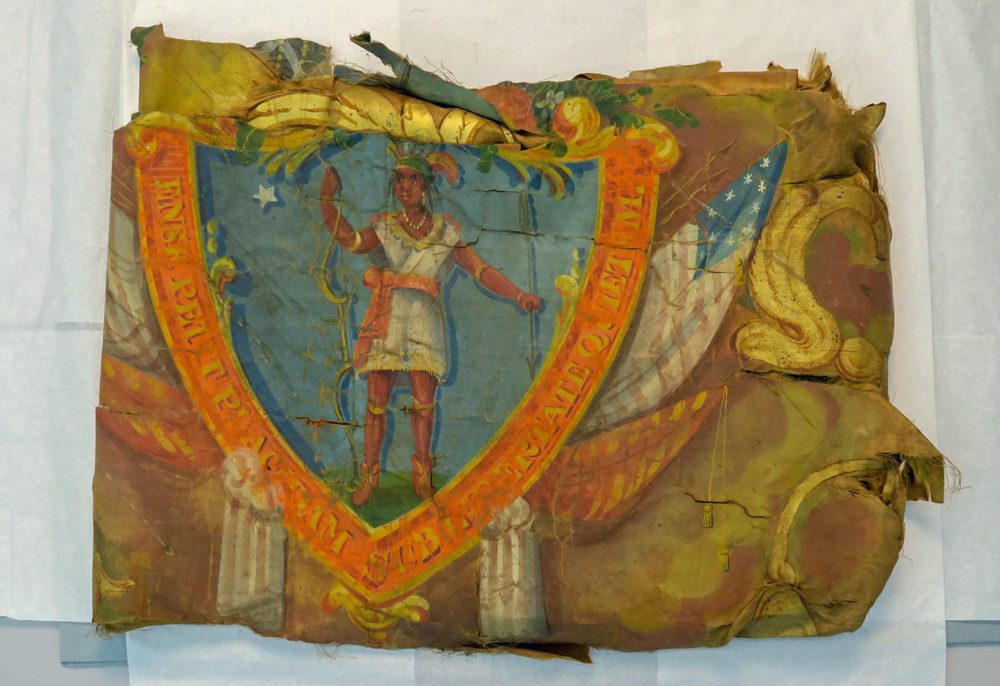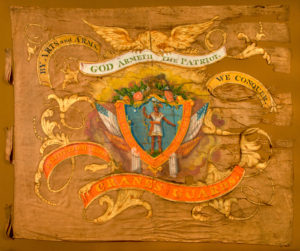True Tales from Canton’s Past: A Bag of Silk
By George T. Comeau
The crumpled Crane’s Guards Flag prior to restoration. See below to view the flag’s transformation. (Courtesy of Windsor Conservation)
That old silk flag must have been glorious. The boys that carried her would have looked resplendent in their uniforms. They were dressed in gray coats, white pantaloons, smart belts, and caps. In the fashion of the early uniforms of West Point, they were magnificent on that day.
Atop their heads a leather shako cap with a bright plume catching the autumn breeze. It was a sight to behold: the Crane’s Guards under the banner of their namesake, Major General Elijah Crane.
What has survived from this early militia is nothing short of astonishing. We have a fully restored drum, a second smaller drum and drumsticks, sheet music that they marched to, a pair of original hats, a handful of buttons from their uniforms and, until recently, a crumpled pile of painted silk. The bag of silk held great promise.
The silk, inside a small plastic bag, was the flag of the Crane’s Guards. The flag was commissioned by the general himself as a way to thank the men that paid homage to him by naming the home guard militia after him. Crane was there on the day they unfurled the flag. It would have been a proud moment for the entire community. The major general’s name is emblazoned on the back of the flag.
Today, just about 200 years have passed, and we have reason to celebrate yet again. The restoration and preservation of the flag has just been completed. Literally, it was a textile that was at the very end of its life — the brink of extinction. As you can imagine, the remnants of the flag were dissolving into dust. Time had taken the cruelest of tolls. The bag that it had been stored in was relegated to a bottom drawer of a lead-lined cabinet inside the Canton Historical Society. Inside the bag were small sections of fringes, flakes of paint and tattered silk remains of a great big flag.
Jim Roache, a curator at the society, has always loved that flag. He would gingerly show it to flag experts in the hopes of learning more about the provenance of the maker or the artist. At some point during the last few years, it was speculated that the flag was likely painted in Boston in 1823 by the firm of Curtises & Hubbard. A Canton boy by the name of George Endicott worked as an apprentice at the shop on Market Street, and Endicott’s father was a hero of the American Revolution and a friend of the general. The connections are both supposition and likely reality.
Roache learned that the flag, depicting on one side the Great Seal of Massachusetts, was perhaps the second oldest militia flag to survive in the commonwealth. What’s more, the seal of the native depicted on the flag is a very rare depiction. As a bag of silk and paint, the promise was in the imagination. The idea to preserve the flag was brought before the 2016 annual town meeting. We all voted unanimously to fund the project at a cost of $18,900. The society raised almost $4,000 to complete the project. It was a large sum of money for what amounted to the potential of a restored work of art and a treasure for the town.

Deirdre Windsor found this one of her greater preservation challenges. (Courtesy of Windsor Conservation)
One person alone could undertake the preservation of the flag. Deirdre Windsor is an independent textile conservator and the principal of Windsor Conservation in Dover, where she has worked on the conservation of textiles and fashion arts since 2002. Windsor managed textiles in Lowell and is the foremost authority in the area. Repairing and conserving this flag was an enormous undertaking. Windsor has handled many of the textiles in the Wally & Marie Gibbs Textile Room at the Canton Historical Society. The flag would be one of her greater tasks. Windsor said that the Crane’s Guards Flag “was in a situation that I had never seen, and to make it whole again presented an enormous challenge.”
For people who love the intricacies of preservation, this project is rife with technical twists and turns and the application of old technology and new engineered fabrics. The process included a thorough cleaning using latex-free cosmetic sponges and a low-suction vacuum. Deionized water was used to manipulate the creases into flat straight lines. The flag was humidified employing a complex process that involved placing the fragile textile on a sheet of spun-bonded fabric. Ultrasonic vapor was used to allow the silk fibers to relax, and then glass weights held the straightened strands. The vapor, shot through a preservation pencil and damp blotter paper, was managed under a Gortex membrane providing close contact to the healing humidity.
Windsor, who has worked on several items in the Canton collection, noted that the process required tremendous patience. “I worked on the fibers at a micro-level,” she said.
And, the patience would pay off. “There was no immediate gratification,” said Windsor. “It was a puzzle to place the painted fabric back into the context of a flag.”
Since a large percentage of the flag had decayed and was no longer present, Windsor found a cotton support fabric that was dyed to match the silk. The flag was then transferred to a custom-crafted, fabric-covered mount, aligned and attached with a special German-engineered fine polyester thread. To complete the project, a custom-made powder coated steel frame fitted with ultraviolet filtering acrylic glass was used to protect this treasure from sunlight. Associate textile conservator Johanna Tower and Diane Boltz assisted with the mount and framing preparation. As Windsor put it, “It takes a team.”

After two years of textile preservation, the Crane’s Guards Flag returned to Canton last week. (Courtesy of Windsor Conservation – click to enlarge)
And there was a hope that both sides of the flag could be exhibited. Alas, stability of the fibers meant that the flag would need a pressure mount and that would preclude viewing the entirety of the flag. Even the mount itself utilizes cutting-edge components. The mount the flag sits upon is an aluminum honeycomb pioneered for use in the space industry. The Small Corporation in Greenfield made the mount that the flag is secured in. These are the same folks who made exhibit cases for Smithsonian’s National Museum of the American Indian and protect artifacts at Frank Lloyd Wright’s Taliesin. The pedigree of the team that preserved this flag is impeccable.
Stepping back, the flag is stunning. What surprised Windsor, and will surprise us all, is how artfully the flag is executed. “As a whole, it is beautiful,” Windsor said. “The composition is masterful and the colors of rusty gold and dusty pinks must have been amazing when new.”
Within days of completing the project, Windsor had Roache come pick it up. “It was so large, I needed to have it removed from the studio,” she said. And the size now presents a new challenge for the Historical Society. Perhaps the Canton Public Library will be a suitable stop on the tour of this preserved work of art. Watch for an announcement soon for a public unveiling and a chance to see the Crane’s Guards Flag in the glory of preserving Canton’s history.
Short URL: https://www.thecantoncitizen.com/?p=48548










